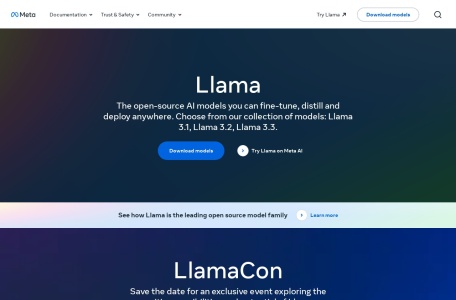
What is Llama 3?
Llama 3 is the latest open-source new-generation large language model (LLM) released by Meta. It includes models with two parameter scales: 8B and 70B, marking another significant advancement in the field of open-source artificial intelligence. As the third-generation product of the Llama series, Llama 3 not only inherits the powerful functions of previous models but also provides more efficient and reliable AI solutions through a series of innovations and improvements. It aims to support a wide range of application scenarios, including but not limited to programming, problem solving, translation, and dialogue generation, by means of advanced natural language processing technology.
The series models of Llama 3
Llama 3 currently offers two models, namely the 8B (8 billion parameters) and 70B (70 billion parameters) versions. These two models are designed to meet application requirements at different levels, providing users with flexibility and freedom of choice.
- Llama-3-8B: An 8-billion-parameter model. This is a relatively small yet efficient model with 8 billion parameters. It is designed for application scenarios that require fast inference and fewer computational resources while maintaining high performance standards.
- Llama-3-70B: A 70-billion-parameter model. This is a larger-scale model with 70 billion parameters. It can handle more complex tasks and provide deeper language understanding and generation capabilities, making it suitable for applications with higher performance requirements.
Subsequently, Llama 3 will also launch a model with a parameter scale of 400 billion. It is currently under training. Meta also stated that after the training of Llama 3 is completed, a detailed research paper will be released.
The improvements of Llama 3
- Parameter Scale: Llama 3 offers two model sizes with 8 billion and 70 billion parameters respectively. Compared with Llama 2, the increase in the number of parameters enables the model to capture and learn more complex language patterns.
- Training Dataset: The training dataset of Llama 3 is 7 times larger than that of Llama 2, containing over 15 trillion tokens, including 4 times as much code data. This makes Llama 3 more excellent in understanding and generating code.
- Model Architecture: Llama 3 adopts a more efficient tokenizer and Grouped Query Attention (GQA) technology, improving the model’s reasoning efficiency and ability to process long texts.
- Performance Improvement: Through the improved pre-training and post-training processes, Llama 3 has made progress in reducing error rejection rates, enhancing response alignment, and increasing the diversity of model responses.
- Security: New trust and security tools such as Llama Guard 2, as well as Code Shield and CyberSec Eval 2, have been introduced, enhancing the security and reliability of the model.
- Multilingual Support: Llama 3 incorporates high-quality non-English data in over 30 languages into its pre-training data, laying the foundation for future multilingual capabilities.
- Inference and Code Generation: Llama 3 shows significantly enhanced capabilities in inference, code generation, and instruction following, making it more accurate and efficient in handling complex tasks.
The technical architecture of Llama 3
- Decoder Architecture: Llama 3 adopts a decoder-only architecture, which is a standard Transformer model architecture mainly used for natural language generation tasks.
- Tokenizer and Vocabulary Size: Llama 3 uses a tokenizer with 128K tokens, enabling the model to encode language more efficiently and significantly improving performance.
- Grouped Query Attention (GQA): To enhance inference efficiency, Llama 3 employs GQA technology in both the 8B and 70B models. This technique reduces computational complexity by grouping queries in the attention mechanism while maintaining model performance.
- Long Sequence Processing: Llama 3 supports sequences up to 8,192 tokens in length, using masking techniques to ensure that self-attention does not cross document boundaries, which is particularly important for handling long texts.
- Pretraining Dataset: Llama 3 was pretrained on a dataset containing over 15TB of tokens. This dataset is not only massive but also of high quality, providing the model with rich linguistic information.
- Multilingual Data: To support multilingual capabilities, Llama 3’s pretrained dataset includes over 5% high-quality non-English data, covering more than 30 languages.
- Data Filtering and Quality Control: The development team of Llama 3 has developed a series of data filtering pipelines, including heuristic filters, NSFW (Not Safe For Work) filters, semantic deduplication methods, and text classifiers, to ensure the high quality of the training data.
- Scalability and Parallelization: During the training process of Llama 3, data parallelization, model parallelization, and pipeline parallelization were employed, enabling the model to be trained efficiently on a large number of GPUs.
- Instruction Fine-Tuning: Based on the pretrained model, Llama 3 further improves its performance on specific tasks, such as dialogue and programming tasks, through instruction fine-tuning.
Similar Sites


Ollama

Sora

AnythingLLM

DALL·E 3

HuggingFace

AgentGPT
Gemma

